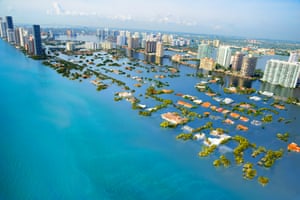
People tend to respond to immediate threats and financial
consequences – and Florida’s coastal real estate may be on the cusp of
delivering that harsh wake-up call
by Megan Mayhew Bergman
by Megan Mayhew Bergman
I stood behind a worn shopping center outside of Crystal Springs, Florida,
looking for the refuge where a hundred manatees were gathered for
winter. I found them clustered in the emerald-colored spring, trying to
enjoy a wedge of sunlight and avoid the hordes of people like me, boxing
them in on kayaks and tour boats, leering over wooden decks. The nearby
canals were lined with expensive homes and docks with jetskis. One
manatee breached the water for a breath, and I could see the propeller
scar on its back.
2018 was the second deadliest year on
record for manatees. Like many of our coastal species, they’re
vulnerable to habitat loss and warming seas, which are more hospitable
to algal blooms and red tide. Science has given us the foresight we need
to make decisions that will reduce the future suffering of other
species and ourselves, but we don’t heed it. Why?Studies show that humans don’t respond well to abstract projections. We overvalue short-term benefits, such as driving SUVs, burning coal and building waterfront real estate. We choose these extravagances even though they impede beneficial long-term outcomes, such as saving threatened species, or reducing the intensity of climate change.
Humans tend to respond to immediate threats and financial consequences – and coastal real estate, especially in Florida, may be on the cusp of delivering that harsh wake-up call. The peninsula has outsized exposure: nearly 2 million people live in coastal cities. In the list of the 20 urban areas in America that will suffer the most from rising seas, Florida has five: St Petersburg, Tampa, Miami, Miami Beach and Panama City. In 2016, Zillow predicted that one out of eight homes in Florida would be underwater by 2100, a loss of $413bn in property.
I flew into Miami in early December and the risk was visibly apparent from the airplane window. Aerial views of Miami and South Beach show high density construction on flat, sandy slivers of land. A recent National Oceanic and Atmospheric Administration (NOAA) predicts Miami streets will flood every year by 2070.

South Beach was vibrant and populated, with mega-yachts docked in front of luxury homes, sorbet-colored art deco-era hotels rising a block from the water, cafes misting customers on the sidewalks, neon signs flashing bright in the night sky. But I wondered: given the forecasts, why are people still building new condominiums?
In Florida, you will see a bewildering mix of optimism, opportunism and denial in the real estate market: luxury condominiums going up in flood-prone South Beach, and property values rising in the vulnerable Keys, post-Hurricane Irma. And though the House of Representatives passed a bill to require real estate agents to disclose flood risks, the Senate has not reviewed it, and a culture of “systemic, fraudulent nondisclosure” persists in high flood risk areas.
You will see the massive benefits of privilege, and the way it allows a homeowner, particularly a second home owner, to afford the risk. You will see emerging issues like Miami’s climate gentrification, where previously low-income neighborhoods like Little Haiti are rising in value and under pressure from developers because of their higher ground, resulting in the displacement of people and place-based culture. Haitian playwright and bookstore owner Jan Mapou recently told a reporter: “Gentrification is coming forcefully: developers buying the major corners, raising the rents, forcing renters onto month-to-month leases … We’re not against development or modernization … but respect the people living there, their culture, their history.”
I spoke with a developer who wanted to remain anonymous, given business interests. He told me that he’s surprised that people are still buying, building and investing in coastal Florida. He estimated that a decade ago, only one in 10 buyers asked about the property elevation, or expressed concerns about rising seas. Today, nearly six of 10 ask and many decide not to buy in these same critical areas. “I’m worried we’re one bad storm away from a rush for the exits,” he told me.
I sought input from the environmental community as well. “Real estate is a huge economic driver here,” Laura Geselbracht, a senior marine scientist with the Nature Conservancy, said. “And it’s at risk from sea level rise. People don’t want to believe it. That’s a normal human condition – suspension of belief.
“If you’re not a millionaire and you own a property in a vulnerable area, it may be a wise decision to think about moving before the masses think about moving,” Geselbracht said. She also owns waterfront property on a canal in Fort Lauderdale, and is deeply invested in her community, but has cautioned her child not to expect the same lifestyle in the future.
She wonders why she doesn’t see more people of means in south Florida buying electric cars, getting solar panels and living more sustainably. “The quicker we take action, the better. We’ve got to be leaders so that we have a longer horizon of survival here,” she said. When she’s approached community leaders in the past, asking them to take steps toward sustainability, she often hears the same response: “Technology will solve it.”
It’s a high-stakes gamble. Consider innovative mitigation in action: raising roads, shoring up sea walls, adding pumps and drainage upgrades, beginning dredging projects, offering complex insurance structures. Proximity to these short-term solutions are not always pluses in a home buyer’s column, but acute reminders of vulnerability.
While Geselbracht is optimistic about developments like Orlando’s zero emissions goal, and Miami’s forward-looking Forever bond, she’s not ready to pin all her hopes on innovation. She also wonders about the fallacy of “safe” investments elsewhere. “There are air quality issues and forest fires out west, and extreme heat inland.”
I spoke with young farmers who recently decided to purchase a farm away from the coast. “As we looked for farmland to buy, we certainly thought hard about what the climate would be like in 10, 20, 30 years,” one of the owners of Ten Mothers Farm told me. “We knew we didn’t want to be near the coast, and we wondered whether even being in the south-east was a bad idea. Ultimately we decided that the most important thing was to be in a community that’s supportive and that we believe will be resilient.”
While baby boomers may be slow to adjust spending behavior to climate change, the Florida developer told me, millennials will not, and that shift will likely impact the market in the decade to come.
I grew up in two eastern North Carolina towns, Rocky Mount and Atlantic Beach, that have been bludgeoned by hurricanes. There, friends have real estate that falls into an increasingly common, and expensive, pattern: flood, repair, rebuild. Many are locked into this expensive, emotionally draining pattern because they can’t sell their homes, which have been flooded multiple times.
Browsing real estate in nearby New Bern, which was dramatically flooded by Hurricane Florence last year, reveals the terminology indicative of this practice. Homes are presented as a “blank canvas” and “waiting to be brought back to life”. There are optimistic takes, too, like “circumstances have created great potential”, and “great fishing”.
According to a 2018 report from the Union of Concerned Scientists, it’s not just houses that will flood, but also “roads, bridges, power plants, airports, ports, public buildings, military bases and other critical infrastructure along the coast”. Furthermore, the report indicates that financial markets have not accounted for this future downturn. The economic impact will be “staggering” and the window for towns to maintain creditworthiness and build resilience is “narrowing”.
The Union of Concerned Scientists point out that “nearly 175 communities nationwide can expect significant chronic flooding by 2045” and of those “nearly 40% – or 67 communities – currently have poverty levels above the national average”. States with areas of particular concern are North Carolina, Maryland and Louisiana, where a significant percentage of at-risk properties are owned by people of color.
The climate change-induced real estate crisis is imminent in the south, and it’s going to have a brutal impact on those who can’t afford new insurance, relocation, lowered property values, or bandages such as private sea walls. It will have an outsized impact on homeowners who live in flood zones or near over-heated superfund sites and toxic factories, and those who can’t afford to pay taxes on submerged land where they can no longer make a home.
I look at real estate listings and wonder, what if the places you love most are no longer a good investment? What if we’re so focused on denial, data and property that we fail to grasp the human side of the situation?
The moral imperative to act is not about salvaging expensive second homes on the waterfront. It is about taking responsibility for human action, helping frontline communities solve a complicated economic and cultural challenge, and doing what we can to help species whose survival is imperiled by our lack of foresight.
No comments:
Post a Comment